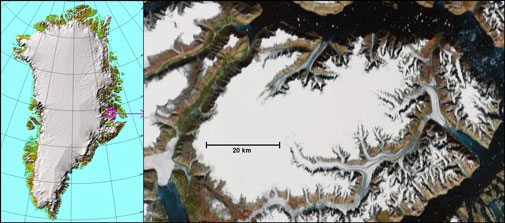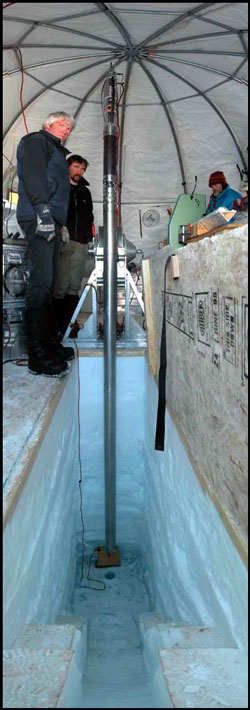About the RECAP project
The Renland ice cap is situated in Eastern Greenland on a high elevation plateau on the Renland peninsula in the Scoresbysund fjord (figure 1).
Climatic conditions on the Renland ice cap are strongly influenced by the varying Arctic sea ice export along Greenland’s east coast. An ice core from the Renland ice cap is thus perfectly suited for obtaining information on Eastern Greenland climatic conditions including the export of sea ice from the Arctic Ocean for the past 100,000 years. We therefore propose the REnland ice CAP project (RECAP).
The RECAP ice core drilled to bedrock will be the backbone of a coordinated science program between Denmark, Germany and the U.S. The shallowness of the Renland ice cap furthermore assures that it does not have a brittle ice zone in the Holocene ice like the Greenland ice sheet. The RECAP ice core can therefore yield the first continuous Holocene profiles of gasses and chemical impurities extracted from Greenland.

Figure 1: Left, map of Greenland, showing the location of the Renland Ice Cap (Danish Cadastre). Right, satellite image of the Renland peninsula, which is almost entirely covered by the Renland ice cap. The dome on the eastern plateau of the Renland ice cap is marked with a purple square.
The Renland ice cap is constrained by the surrounding topography and its eastern plateau reaches an elevation of 2340m at its summit, where the thickness of the ice cap is almost 400m and the accumulation rate approximately 0.5m of ice equivalent precipitation per year . Brittle ice, that is very detrimental to ice core quality, forms at depths below 600m, hence in contrast to the main Greenland ice sheet, the Renland ice cap contains no brittle ice zone. An ice core from Renland will therefore also yield the first continuous Holocene profiles of gasses and chemical impurities from Greenland.
Given the unique location and properties of the Renland ice cap, the RECAP core will provide data with direct bearing on the following high-priority science questions:

Figure 2: The Hans Tausen intermediate drill system in operation during the 2006 Flade Isblink ice core project.
1) How did the East Greenland and thus Arctic sea-ice conditions evolve during the Holocene and the Glacial and how did conditions and variability compare to the present downturn in sea ice?
2) How did the atmospheric composition, including pole-to-pole gradients in trace gas contents, change during the entire Holocene?
3) What is the East Greenland signature of the abrupt climate shifts seen during the last Glacial?
4) Has the Renland ice cap always had the same shape and size, so the climate record from a Renland ice core can be assumed to stem from snow deposition on a site with unchanged elevation, yielding a Greenland climate record at fixed elevation?
These science questions are directly influencing how the scientific community will interpret the present decline in Arctic sea-ice; our future understanding of the dynamics of the climate system; our interpretation of Human and natural influences on the Earths atmospheric composition; and our future interpretation of the ice cores from the main Greenland ice sheet. To address these, as well as numerous other science questions, we propose to drill the RECAP core through the Renland ice cap down to bedrock. The core will be drilled with the modern well-proven Copenhagen intermediate drill system, capable of drilling high quality 4 inch diameter cores in liquid-filled boreholes (figure 2).
[1] Johnsen et al. 1992, A”deep” ice core from Eastern Greenland, Medd. Grøn., Geoscience, 29, 1992.
